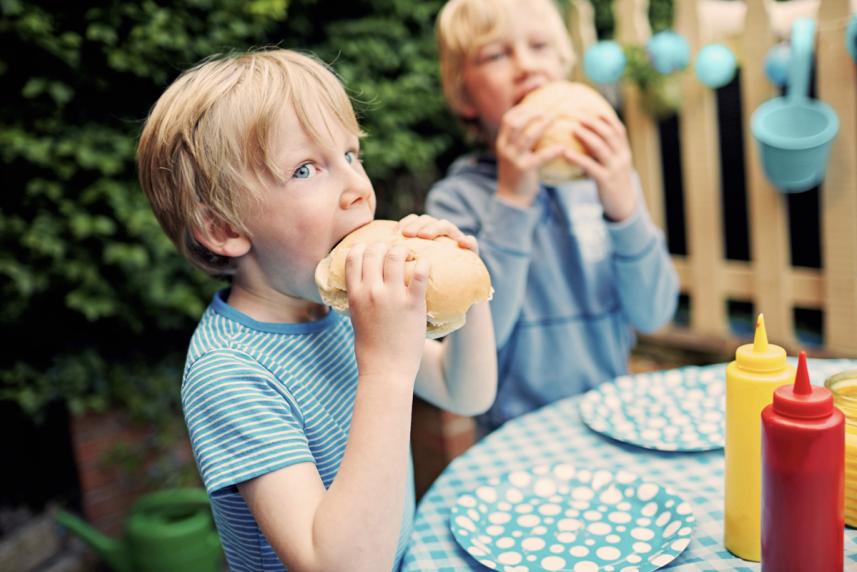
We have more than 90,000 doctors at over 2,000 locations. Our team will help you get the care you need, when and where you need it.

It’s peak season for foodborne illness. So, before you fire up the grill, learn how to sidestep common mistakes that increase your risk of getting sick.
Communities come alive in the summertime. There are Little League games to attend. Block parties to throw. And plenty of picnics and backyard barbecues to host. Know what else comes alive in the summer? Foodborne germs. They love warm, humid weather. And they can multiply fast.1 No wonder summer is peak food poisoning season.2 Keep your outdoor feast safe by following these essential food safety tips.
A summer outing almost always starts with packing a cooler. Maybe you’re bringing drinks and salads. Or, you’re in charge of sandwiches and raw meats for the grill. Whatever you’re bringing, you want to keep it cold. Here’s how:
Pack in plenty of cold sources. Those include ice, gel packs and even frozen juice boxes or water bottles. And fill coolers up all the way. Full coolers will stay cold longer than half-empty ones.1
Try not to open coolers too often. And don’t leave them open for too long. If you can, pack drinks in their own cooler. It’s likely to be opened more often as people help themselves. Only have one? Just pack drinks on top so they’re handy.1
Keep coolers in the shade or covered with a blanket. While traveling, stow them inside the car where the air conditioning is running, not in the trunk.4
Keep a thermometer in your cooler to check the temp. If it gets above 40°F3, add more ice if possible. If you can’t, the food will be safe for about two more hours. After that, it’s best to trash what’s left.1, 2

We have more than 90,000 doctors at over 2,000 locations. Our team will help you get the care you need, when and where you need it.
Raw meat can have dangerous germs on its surface. If you’re not careful, they can get on fresh produce or ready-to-eat foods. This is called cross-contamination. Here’s how to keep it from happening2:
Use separate cutting boards, knives and other utensils for meat and fresh produce. If something touches raw meat, set it aside.
Wash those utensils with soap and very hot water before using them for anything else. That includes your hands. If you don’t have running water, use hand sanitizer to clean hands. Clean cutting boards, utensils and surfaces with alcohol wipes.
Do not place cooked meat on the same platter that held raw meat. Serve cooked meat directly from the grill. Or move it to a separate clean plate or platter for serving.
Meat is a common culprit for foodborne illnesses. To kill the germs, you’ll need to get those burgers and steaks to a certain temperature. Here’s how:
The best way to ensure that meat is thoroughly cooked is to use a meat thermometer. Stick the thermometer into the thickest part of the meat. For thin, flat cuts of meat such as hamburgers or steak, try sticking the thermometer in through the side.
Keep cold foods below 40°F and hot foods above 140°F. Anything in between is the danger zone. Germs can grow very quickly in this temperature range. They can double in as little as 20 minutes. That’s according to the U.S. Department of Agriculture.
If foods are in this temperate range for more than two hours, throw them away. Germs grow even faster between 90°F and 110°F. If it’s warmer than 90°F outside, don’t leave food out for more than one hour.
Try some of these strategies to keep your outdoor food at a safe temperature:
Keep cold dishes over ice. Place a bowl of cold salad into a larger bowl filled with ice. Or set cold platters over a baking sheet filled with ice. Another idea: Serve cold foods quickly, then pop the containers back into the cooler to store.
Don’t forget about condiments. They need to be on ice, too.
For hot dishes, consider using a chafing dish. This is a dish propped over a heat source. Professional caterers use these to keep dishes hot. You can find low-cost ones at party supply stores.
If you have access to electricity, plug in a slow cooker or hot plate to keep foods warm.
Set up a “holding zone” on the grill. This is a spot that’s not directly above the coals or flames. Put cooked foods here to keep them warm.
Keeping foods covered will also help hold temperatures. It keeps bugs away, too.
Check the temperature of foods often to make sure they’re not in the danger zone. Be sure to use a different thermometer than the one you used to measure the meat temp. If you don’t have two: Clean it with an alcohol wipe before using it again.
Storing and keeping food at a safe temperature outdoors will always be a challenge. But with careful planning, you can pack only what you’ll need so nothing goes to waste.
If you want a little less stress, work some of these dishes onto the menu. They hold up to the heat better:
Dry snacks such as chips, pretzels, crackers, or trail mix. These foods are unlikely to have harmful germs that will grow in warm weather. Skip the meat-and-cheese platter. Fill one with crackers, dried fruit and nuts.
Dips made without dairy. If you need a dip to go with your snacks, choose ones made without dairy or mayonnaise. Those can spoil quickly. Salsa, guacamole and hummus are safer options.
Fresh fruit or fruit salad. Whole fruit is portable and safe at any temperature. Just be sure to wash it with clean water before leaving the house. A fruit salad dressed with lime juice and honey (not yogurt) will also hold up well.
Slaws and salads dressed with oil and vinegar. Dress salads and slaws with oil and vinegar or a vinaigrette (a sauce made of oil and vinegar). Don’t use with dairy products. To keep salads crisp, store the dressing on the side. Toss it just before serving.
Sources
© 2024 Optum, Inc. All rights reserved. Do not reproduce, transmit or modify any information or content on this website in any form or by any means without the express written permission of Optum.
The information featured in this site is general in nature. The site provides health information designed to complement your personal health management. It does not provide medical advice or health services and is not meant to replace professional advice or imply coverage of specific clinical services or products. The inclusion of links to other websites does not imply any endorsement of the material on such websites.
Stock photo. Posed by model.